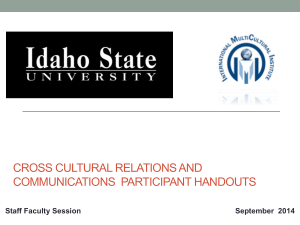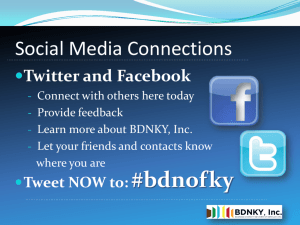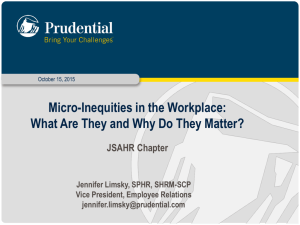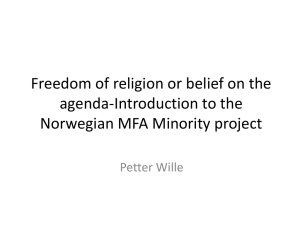"Barriers to Equality: the Power of Subtle Discrimination,"
advertisement
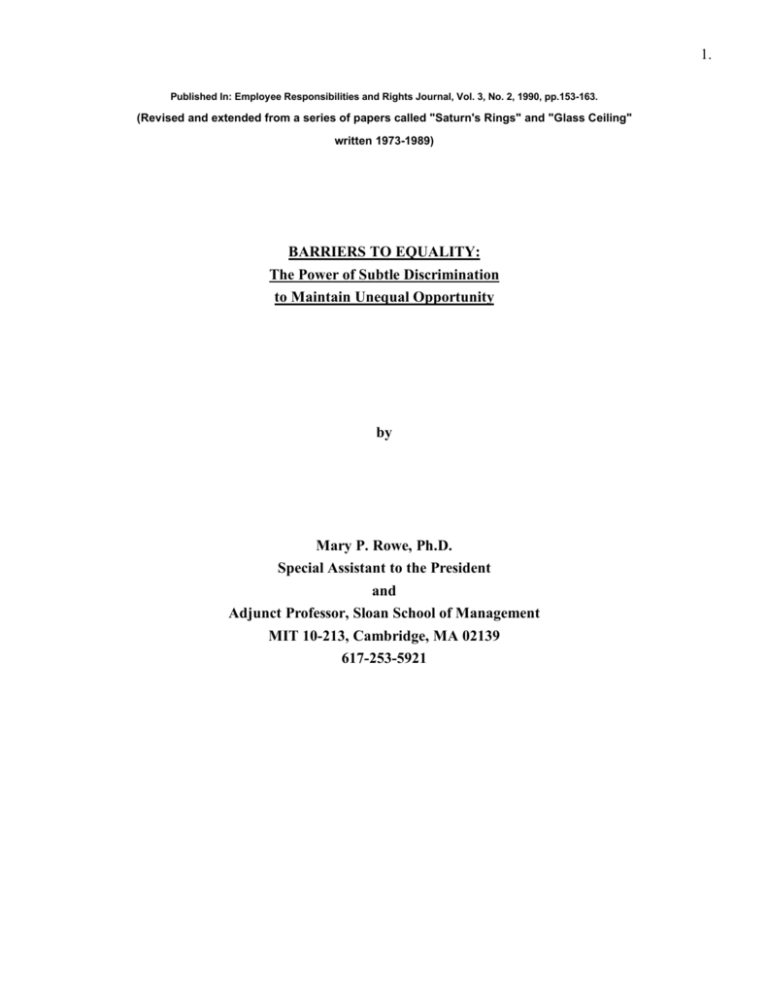
1. Published In: Employee Responsibilities and Rights Journal, Vol. 3, No. 2, 1990, pp.153-163. (Revised and extended from a series of papers called "Saturn's Rings" and "Glass Ceiling" written 1973-1989) BARRIERS TO EQUALITY: The Power of Subtle Discrimination to Maintain Unequal Opportunity by Mary P. Rowe, Ph.D. Special Assistant to the President and Adjunct Professor, Sloan School of Management MIT 10-213, Cambridge, MA 02139 617-253-5921 2. ABSTRACT BARRIERS TO EQUALITY: The Power of Subtle Discrimination to Maintain Unequal Opportunity Prof. Mary P. Rowe, MIT This paper argues that subtle discrimination is now the principal scaffolding for segregation in the United States. The author suggests this scaffolding is built of "micro-inequities": apparently small events which are often ephemeral and hard-toprove, events which are covert, often unintentional, frequently unrecognized by the perpetrator. Micro-inequities occur wherever people are perceived to be "different": Caucasians in a Japanese-owned company, African-Americans in a white firm, women in a traditionally male environment, Jews and Moslems in a traditionally Protestant environment. These mechanisms of prejudice against persons of difference are usually small in nature, but not trivial in effect. They are especially powerful taken together. (As one drop of water has little effect, though continuous drops may be destructive, one racist slight may be insignificant but many such slights cause serious damage.) Micro-inequities work both by excluding the person of difference and by making that person less self-confident and less productive. An employer may prevent such damage by developing programs on diversity, like "valuing differences" and team-building. The author does not believe micro-inequities should be made the subject of anti-discrimination legislation. Key words: Subtle discrimination; Micro-inequities; Harassment Occupational segregation; Glass Ceiling; Inequality; Racism; Sexism 3. BARRIERS TO EQUALITY: The Power of Subtle Discrimination to Maintain Unequal Opportunity Prof. Mary Rowe, MIT 10-213, Cambridge, MA 02139 "She cannot represent us in Washington; she isn't even pretty!" "Don't try to build a career in that company, Aaron; they are very traditional. Because of who you are, you will never make it to the top......" "Check his work for a few weeks, will you, Henry? His grades are good, but you can't tell with someone from a black college." In recent years there has been much discussion of the glass ceiling, the invisible barrier that keeps women and African Americans, Latinos and other minorities, from going to the top of traditionally "Anglo", male institutions. There is also an emergent discussion about whether Caucasians, (as well as blacks and women), can make it to the top in companies run by Asians. Glass walls are equally impenetrable; glass walls keep women and minorities barriered from certain occupations within society and within institutions; it is easy for each of us to observe occupational segregation in our own places of work. There are of course several reasons for the glass barriers. For example, an important difficulty for women is the need for family supports, like adequate leaves and child care. It is the hypothesis of this article that subtle discrimination contributes also much to the glass barriers; it is the practical, (not necessarily conscious) manifestation of the fact that senior managers want to choose people like themselves to succeed them. I believe that subtle discrimination is now, in most workplaces, the principal scaffolding for segregation in the United States, the framework for discrimination against everyone who is obviously "different" from the person making decisions about whatever is the matter at hand. 4. Most major US institutions have long since begun to address major manifestations of prejudice. In many companies, a major act of discrimination that could immediately be proven, would immediately be rectified, if brought to the attention of senior management. However, subtle barriers maintain their strength, for example, not inviting African Americans to strategy meetings, leaving women home from field trips, blaming problems on the person who is obviously different, expecting failure from the person of difference. As we enter the 1990's, a decade in which it is expected that only about one in ten of all net new entrants into the US labor force will be an Anglo white male, diversity will be the most important aspect of the US labor force, and the glass barriers will become even more critical. Subtle discrimination is a timely topic for all training programs on workplace civility, on valuing differences and on harassment. There has been much discussion of whether discrimination works by keeping minority people out, or by affecting the minority person so that he or she behaves in an unacceptable or unproductive fashion. Blame the aggressor? Or blame the victim? This paper suggests that discrimination maintains itself in a wide variety of ways, working within the dominant culture and within the person discriminated against. The mechanism functions through a wide variety of "micro" events, in the terms of this paper, micro-inequities. The analysis is drawn from seventeen years as ombudsman to MIT and as a consultant to companies in North America. All the quotations which follow are real. Nearly all are from 1989. Although some will find the examples banal and trivial, for the persons who were the objects of each example, these sentences were full of pain. This indeed is the point of the paper. WHAT ARE MICRO-INEQUITIES? WHY LOOK AT THEM? It will become obvious, from the discussion that follows, that each person is his or her own expert on what constitutes a micro-inequity in any given instance. Discriminatory micro-inequities are tiny, damaging characteristics of an environment, as these characteristics affect a person not indigenous to that environment. They are distinguished by the fact that for all practical purposes one cannot do anything about them; one cannot take them to court or file a grievance. 5. They are actions which, reasonable people would agree, are unjust toward individuals, when the particular treatment of the individual occurs only because of a group characteristic unrelated to creativity and work performance, (for example, sex, race, religion, age, or country of origin). ("You cannot send her to represent us in that negotiation; most of their top people are European. She will be treated politely but she won't be taken seriously." ......"Would the Senator's staff be convinced by a black lobbyist?") These are the situations where a minority person is not introduced; when mail is addressed to a male rather than a female technical manager, because it is presumed that he is technically more competent. These are the comments about physical appearance, ("You make me think about about tepees and tomahawks,") in talking with a Native American colleague. These are the presumptions, uncountered by Anglo male superiors, that a Latina cannot negotiate the contract in Japan; or that it is professionally acceptable to show sex films at a professional conference, ("It's OK. We warned the ladies about the porn flicks, so if they want to, they can stay away from the evening meetings.") This is the hand on the knee from a senior vice-president at the banquet table; these are the disrespectful comments to an African American member of the board, ("Martin Luther King Day is just a foolish and costly gesture to yet another special interest group.") These are the two-sided stereotypes about technical ability, ("Hey, Paul Wu, you made a mistake in math! How come? I thought you guys never made a mistake!" ....."We hired an Hispanic engineer and he was incompetent; never again.") This is the super competent, white American who will never make it to the top of a Japanese company, though he was brought up in Japan, is bilingual, and can "pass" on the telephone. There is a useful literature about where these phenomena come from, why people overlook or fear or put down those whom they perceive to be "not like us." In studies of racism Dr. Chester Pierce calls many of these micro events, "microaggressions" (Barbour, 1970). Jean-Paul Sartre has written about these phenomena as the expectations of anti-Semites about what it means to be a Jew (Sartre, 1965). One may think of subtle discrimination as a projection of our negative feelings about ourselves, or as a scapegoating process, supported by myths and by selective perception which supports the myths. This article is about the effects of subtle discrimination and how it works. 6. Micro-inequities are fiendishly efficient in perpetuating unequal opportunity, because they are in the air we breathe, in the books we read, in the television we all watch, and because we cannot change the personal characteristic which leads to the inequity. Micro-inequities are woven into all the threads of our work life and of US education. They are "micro", not at all in the sense of trivial, but in the sense of miniature. I write about these events, in this paper, with a focus on racism and sexism. However, the same points may be made with respect to nationality, religion, age, handicap, and many other dimensions of diversity, especially as the US internationalizes and becomes more heterogeneous. HOW DO THE MINUTIAE OF DISCRIMINATION MAINTAIN THE GLASS BARRIERS? I know of no systematic, scientific study of "micro-inequities," but one can suggest many hypotheses as to why such behavior may do damage. I personally do believe these inequities cause serious damage; I believe they are the major explanation for glass barriers. I will therefore set forth my hypotheses. I believe that micro-inequities exert their influence both by walling out the "different" person, and by making the person of difference less effective: • Micro-inequities sometimes cause damage because they predispose a manager to even worse behavior. Thus "seeing through" an "invisible" African American, or paying no attention to support staff women, may make them feel like part of the furniture. This habit may also lead to underpaying minorities and women, because the senior person has little idea what the "invisible people" actually contribute. It may also lead to overlooking someone who might be the best-qualified person for promotion. Every experienced manager has seen examples where a senior person will start recruiting from outside, while "not seeing" the woman in front of him who has been a significant contributor, and who could be promoted. ("What really hurt was that then I was expected to train him to do the job...") • In addition to the above, some micro-inequities cause extended damage, because at the time they occur they are preventing better behavior from occurring. If an executive assistant is unreasonably overloaded with routine or personal work 7. for a supervisor, she may be prevented from doing the kind of creative work that would have prepared her for promotion. ("I would like to be taking on the accounting, but he just sees me as the person who bought his wife's Christmas presents so skillfully...") • Micro-inequities may also have a negative Pygmalion quality. That is, the expectation of poor performance, or the lack of expectation of good performance, may do damage because managers and students and employees have a strong tendency to do what is expected of them. The Asian-American who is expected to be docile may later be thought not to be sufficiently assertive. ("He just called me in whenever he needed error-free, technical work on no notice and with no back talk. I would stay up all night. At the end of the year my evaluation said I didn't speak up enough.") • Micro-inequities cause damage in part because they are a kind of "punishment" which cannot be predicted, in any functional sense; micro-inequities are irrational. That is, by and large, they occur in the context of merit, and of striving for excellence, but do not have anything to do with excellence or merit. This is, of course, by definition what makes them "inequities;" that the punishment occurs in the context of work but without relevance to performance. ("It was the damndest thing; he got off the phone from talking with his daughter, and he blew up at me (the only woman in the group) about a budget proposal that I did not have anything at all to do with!") It is therefore important to look at such phenomena in the context of what we know from behavior modification theory. As an intermittent, unpredictable, "negative reinforcement", micro-inequities have peculiar power as a negative learning tool, (unpredictable, intermittent reinforcement being a powerful type of reinforcement.) Moreover because one cannot change the provocation for negative reinforcement, (for example, one’s race or gender), one inevitably feels some helplessness. • Micro-inequities are often difficult to detect or be sure about. ("I can't put my finger exactly on it. But white institutions are just cold.") This means for one thing that it is hard for the subject to take effective action; ("Tell me, how can I fight a wisp of fog?") It also means that frequent targets of inequities, like Latinos, Native Americans, Asian Americans, African Americans and women, may constantly range through emotions, from legitimate anger (which may or may not 8. have a constructive outlet), to paranoia. The constant experience of being uncertain, about whether one was “left out” or put down, inevitably leads to some displaced and misplaced anger. ("I spend my day going through changes.") Any misplaced anger itself is a problem, because it may in turn offend innocent (or not innocent) bystanders. Uncertainty may also lead to ignoring real insults in such a way that they persist. • Micro-inequities are also often not intentional in any conscious or even unconscious way, even when objective observers would agree that they exist -that an injury really took place. This is another reason they are hard for a victim to respond to. ("I know that no one meant for me to feel out of place. But I could not stand the belly dancers at the dinner. I hated the annual sales meeting after that.") We are all socialized to believe that intent to injure is an important part of injury, and it is certainly critical to our actually dealing with injuries at the hands of others. Faced with a micro-aggression, the victim may not be certain of the motives of the aggressor, and may be unwilling to engage in hostility where no injury was intended. Under conditions of uncertainty about motives, most victims are sometimes in the position of either not getting angry when they should, (which reinforces the aggression and may weaken the victim's professional image and selfimage), or of protesting sometimes when no injury was consciously intended even though it actually occurred. The latter situation is occasionally salutary for all concerned, especially if the aggressor reacts by acknowledging that an injury took place. But sometimes the aggressor is totally unaware of aggressing, even though observers would agree that injury took place. The aggressor may then respond to protest with bewilderment, frustration, humiliation, anger, feelings of betrayal. Or, what is worse, the aggressor may then undermine the minority person who challenged him. ("He said that my joke was racist. Do you think he is really on the team?") • Micro-aggressions and inequities grow in infinite variety. It is hard to stay ahead of the proliferation of types, let alone the number, of petty injuries. For this reason minorities and women may find themselves being too alert for some new kind of insult, because of past frustration. And every experienced manager is familiar with apparently inappropriate anger from someone who was probably responding to "the last war" and not the present one. ("I blew it. It was one too many. He just asked who could possibly have done this brilliant work. I did not 9. realize it was a compliment. I felt totally insulted and blew up; I cannot believe I did that.") • Micro-inequities also cause damage in part because they take up time and energy. Sorting out what is happening, and then dealing with one's pain and anger, take work. ("The worst thing, after she was so mean, was not being able to concentrate; I could not seem to think straight that whole week.") Moreover, studies show that extra time is also required of many minorities and women to help deal with the pain caused by micro-inequities suffered by other minorities and women, because people of difference turn to each other for advice and solace. ("I get calls from people almost every night, about what happened to them that day.") • Communications between genders and among different ethnic groups are sometimes more difficult than between persons who are alike. It is also harder to make sound judgments about persons of difference. Micro-inequities worsen difficult communications, and difficult communications also increase subtle discrimination. It is obvious that none of us knows what it was like to be brought up as a member of the other sex or of a different race. And the forms of racism and sexism are so specific that each group is isolated from the other's experience, and therefore may not intuitively understand the pain of others. Thus, small inequities can add to the fact that cross-group communications are already slower and more difficult; and that cross-group judgments are harder to make well. For example, a white supervisor may find it hard to evaluate the leadership abilities of a person of color -- and then, through prejudice, also fail to give constructive criticism and adequate feedback. ("Nobody ever criticized my work or made any suggestions. They just never promoted me.") This sometimes happens quite consciously when a white male supervisor is afraid to mention a performance problem, ("She seems so touchy!") . The lack of communication and subtle discrimination then feed off each other and may lead to a downward spiral. ("If she weren't black, she would have been fired long ago, but nobody has ever said a thing to her.") It is becoming increasingly common not only to find this difficulty between minorities and nonminorities, but also between minority groups. For example, Asian Americans and African Americans may have difficulty making and then expressing appropriate judgments about each other's work, due to strong differences in cultural background exacerbated by subtle discrimination. 10. • Micro-aggressions seem petty, in a world where available redress may often seem heavy-handed or too clumsy a tool. This is a problem even for those who appear to have some power. Formal grievances, going to court, and appeal to the CEO are heavy weapons; using them is often thought to carry high cost. The perceived lack of appropriate modes of redress therefore helps to perpetuate micro-aggressions. This is especially true where the aggrieved person does not want to lose privacy or professional image. What can an African American vicepresident do, if someone he is negotiating with sneers in private? What can a female plant manager do, if the boss stares directly at her bosom whenever they are alone? Until the person of difference learns how to handle these events effectively, (which takes work), the apparent lack of redress is, at best, frustrating. ("I am a first-rate engineer. I do not want to be known as a 'harassment case'; I do not see that there is anything I can do about his touching me.") DO MICRO-AGGRESSIONS DO MORE HARM TO MINORITIES AND WOMEN THAN TO WHITE MEN? Don't micro problems just "happen to everyone"? ("Haven't you just been describing the general inhumanities of large organizations? ") Is this really discrimination? ("I harass everybody, Mary. I don't discriminate.") This question sometimes arises when an employer has done an employee attitude survey on racism or sexism without a white male control group; white males may protest. ("We also get treated terribly. We just don't complain about it; we get on with the job.") Let me raise here hypotheses as to why micro problems may be worse for minorities and women than for the "average" white male; (I do not mean to say that male Caucasians are impervious to mean behavior.) Some of the hypotheses as to why micro-inequities may do more damage to minorities and women are, of course, analogous to the hypotheses as to why they do damage at all. • "General" harassment often takes a specifically sexist form when applied to women, a racist form when applied to African Americans, and so on. Instead of saying to some average white male, "Your work on this project has been inexcusably sloppy, you blinking idiot; you'll never make it that way!", the remark may come out, "My God, you think no better than my wife; why don't you go home and have babies!", or, "We will never be able to make up for the generations of Southern schools that produced you!" The harassment of African 11. Americans piles up in allusions to race, the harassment of women as allusions to sex roles and sex, instead of being randomly applied, or appropriately focused on work. Like the dripping of water, random drops may do little damage; endless drops in one place can have profound effects. ("I got A’s in college, and here I am losing all self-esteem; I feel as if I can't do anything right.") This is especially important where the "micro" problem is sexualized behavior, and where the object of the aggression was sexually abused in childhood, (or saw someone like themselves sexually abused). Thus the estimated 20-35% of women and 5-15% of men who were sexually abused in childhood may be especially vulnerable to even quite minor sexualizations in the workplace. ("I know this sounds crazy, but I feel as if I had been raped.") • Many minorities and women were socialized to respond disproportionately swiftly to disapproval. Parents often teach their daughters to cooperate rather than to compete with men. Some African American parents teach their children to be sensitive and cautious about anger and criticism from white males. And I find it is sometimes difficult to persuade Asians and Asian Americans to resist harassment that whites and other US minorities will no longer put up with. Conversely one can find many white males who were explicitly socialized to expect hard knocks, to compete ferociously and openly, even (or especially) when injured, and to have a very high pain threshold. It would be hard to prove that either kind of socialization is "right" or "wrong" in absolute terms, but it is easy to see how these cultural paths run afoul of each other. If a white male supervisor shouts angrily for five minutes at a young woman, she may not wholly "recover" from the attack for weeks or months. ("I never asked him a question again. I avoided him whenever I could until I got out of there.") Later, in a discussion with the supervisor, one may hear that he's completely forgotten his "random grouchiness," or thought it was trivial. Thus, behavior that might be trivial or survivable for the average white male may be quite destructive to others, in a manner that has nothing directly to do with the work at hand. • Micro-inequities are more often reported where more powerful people have offended less powerful people. (I think no one knows whether they originate more in this direction than in the reverse. Perhaps power is corrupting; perhaps aggressive underdogs are always eliminated over time or, more likely, more powerful people ignore or are not so easily injured by micro insults from below. 12. Perhaps the generally higher pay and status of the more powerful gives adequate recompense.) In any case it is generally the less powerful who have most difficulties in coping with inequities, since less powerful people by definition have less influence. It is especially difficult to stop an aggressor who is a supervisor. ("What do you mean, did I speak up when he insulted me? Are you kidding? He's my boss!") Disproportionate numbers of less powerful people are minority and female; these groups are therefore statistically more vulnerable to micro-inequities. • In a traditionally white male atmosphere it is much harder to get certain kinds of micro-inequities to stop, because the slights are culturally so "normal" that they simply are not noticed. Many whites are acutely uncomfortable around persons of color; they ignore them or fail to look at and address them -- but do not notice it that they are doing so. Sexy calenders on walls; "humorous" surveys and cartoons about sex; "humorous" mimicry of the handicapped and of other races; ethnic and sexist jokes; and the use of sex in ads, announcements and in computer hacking, are so ubiquitous that many whites and many men literally do not notice them. ("I complained about some extremely offensive girlie calendars in the machine shop. He said, 'What calendars?' He did not even see them!") • Traditionally white male environments may even reinforce certain kinds of discriminatory behavior which are perceived as actively enjoyable, like the aggressive and humiliating recounting of sex and ethnic jokes, or handicap jokes. ("You should see Chris. Chris does a spaz routine, dragging his leg on the street. It'll really crack you up.") This reinforcement may directly interfere with the pursuit of excellence. ("The recruiting team got a reference that said: ‘She is not very creative. Of course you can hire her if you want, but if I were looking for someone new in the lab, I'd rather have her body than her mind.’Can you believe it? They did not return the reference; they said, ‘Let’s hire her!’”) • There is a more acute role-modelling problem for persons of difference, because of their constantly witnessing micro-inequities against others like themselves. That is, disproportionately more Latinos, African Americans and women see people "like them" put down or ignored or ill-served by their superiors and elders. ("After what happened to Carlos, I just gave up.") This point may be clearer when one remembers that in most work environments, the principal (if unintended), same-sex and same-race role models, for persons of color and 13. women, are clerical workers and hourly workers, and these are the groups most frequently reporting micro-inequities. This inadvertent, damaging role-modeling is even stronger because nearly all minorities and women are continuously being taken to be holding the lower level jobs traditionally held by minorities and women, even if they are managers. ("I am constantly being taken to be a file clerk," says a African American woman engineer. "I constantly feel a struggle to develop my own self-image, but it is not affirmed by most of the world around me, as it is for my majority male colleagues.") • It is often harder for minorities and women to find mentors to help them deal with micro-inequities. There are so few senior minorities and women in most organizations that junior members of the community cannot, on the average, find the same amount of high-status, same-race, same-sex mentorship that white males can find. Frequently the higher-status women and minorities try to compensate by spending extra time as same-sex, same-race mentors. It is however, almost inevitable that the burden of dealing with micro-inequities falls on senior people who are already somewhat disproportionately drained of energy by caring for others. This is of course an especially powerful support to glass barriers. ("I went to see a brother in upper management, and told him what had happened to me. He just stood looking out of the window, clenching his fists.") • There is another reason why it is sometimes hard to find an appropriate mentor when a woman and/or minority person is offended by a micro problem. If one goes to a white male, he may or may not understand. If one goes to a friend of the same race and sex, he or she may be just wonderful in helping one to deal with it, or may not be helpful at all. ("I told her he put his hands under my blouse. She asked me if I were wearing a slinky black blouse that day.") That is, listeners of the same sex and race may be so discouraged and bitter, or so full of denial, that they are worse than useless. In sum, I believe that it is often more difficult for minorities and women to find adequate help in dealing with racism and sexism, than for majority men to deal with "general inhumanities." I believe many minority and women managers, students and employees have disproportionate need for supportive white male mentorship, and are disproportionately injured when an advisor or teacher or supervisor assigned to them is just generally unfriendly. Let us take a hypothetical 14. example, Awilda Hernandez, who is a management trainee in a Mid-west bank. She has a need for support if only because she will inevitably live through many micro-inequities. She needs someone to advise her about advancement in an Anglo male environment, because it is foreign to her. The support that she gets from back home is not likely to be professional support. She is in other words less well supported by the general society and may be less well supported by her family than if she were a white male. If her supervisor turns out to be generally inattentive, grouchy or cold, ("What do you mean am I a mentor? Cream rises to the top; mentorship is a bloody waste of my time,") she has been deprived of a mentor in circumstances where she, more than others, needed a mentor. The situation will be compounded if she is afraid to ask for a new advisor or does not know how to find substitute help. This paper has suggested many reasons why the problems of microinequities for minorities and women go beyond the general inhumanities of large organizations. The point may be clearer if you will imagine, (this is a real example), being a solo, young, white, male, child care worker in a large, conservative, inner-city day care system. The "general harassment" might include sincere questions and snide comments on your sexuality. Other white males might find you odd. Women might distrust your skills, ("Wait, Jim, let me show you how to do that,") or your interest in children, ("Are you married?") You might be in fact inept, in some ways, your first year. You might be very sensitive to just runof-the-mill anger from your cross-sex, perhaps cross-race, supervisor. You might find the constant assumption that women-are-better to be very oppressive -- the ads, the jokes, the pictures of women and children on the walls, the many fathers deprived of custody. You might have no one like yourself to turn to. You might get to hate always being asked to fix things. ("I was constantly being asked why I wanted to be there, as if I might molest the children, or drop a baby.") I believe that discriminatory behavior itself causes pain, and also may constitute for minorities and women a situation they cannot control, evade, or ameliorate (or, as we have said, they may see it that way.) Continued experience of destructive situations which cannot be improved can start unhappy cycles of behavior ranging from declining self-esteem (which makes one feel still less efficacious in changing the environment) to withdrawal, resignation, poor work, fantasies of violence, and so on. ("I struggled for days to deal with my anger at 15. what he said; I will never forget that bastard as long as I live. If I ever find myself in a position to do him in, you can bet I will do my best.") At the very least it either takes a lot of energy to deal with an environment perceived as hostile, or it takes lot of energy to maintain one's level of denial of difficulties. In my own environment, as in all others in the US, I believe microinequities cause stress. Over the years there have been occasional, unpublished studies at MIT about the performance of men and women, for example the inhouse surveys of “sex-blind” admissions. These studies typically show that women and men do randomly as well as each other. However, women also regularly report high stress levels and lower self-esteem, for example, in a study of the academic environment for male and female graduate students, (Committee on Women Student Interests, 1987, not published). Small departmental studies report pain from micro-inequities (e.g., Barriers to Equality, 1984, not published). Persons of color also report pain from micro-inequities, (Racial Climate Report, 1988, not published). ARE MICRO-INEQUITIES EVER USEFUL? Occasionally one will find someone who believes that hardship is good for people; creativity requires incessant pain; harassment inspires excellence. ("My parents were immigrants; I made it through -- so can everyone else.") It is hard to respond to these ideas because individual situations vary so much. The speaker who remembers having survived terrible hurdles may also have had exceptional health and energy, or a wonderfully supportive parent or uncle or religion, or extended family -- or may be the only person of his or her type ever to have survived that background -- or may have come through "successful", but terribly scarred. I think most of us believe that challenge is good, (in the right doses), that creativity requires intense concentration and effort, and that excellence itself, and high expectations, inspire excellence. But most people believe that intermittent positive reinforcement, -- that carrots -- are more powerful than sticks. I personally do not believe our world to be so devoid of sticks that we need more of them. And there seem to me to be enough good reasons to believe that micro- 16. inequities cause damage, that we should try to ameliorate them. The Law of Parsimony would suggest that it is simplest to assume that human ability is randomly distributed. ("We could double the numbers of excellent managers and scientists in the US, if we knew how to provide real equal opportunity for minorities and women.") Is this not a sufficient incentive for us to try to undo damage that occurs? Is it not more reasonable to assume people survive in spite of damage rather than because of it? WHAT CAN BE DONE? I do not believe that subtle discrimination can or should be legislated, made the subject of formal policy or dragged into formal grievance procedures. Obviously anyone who feels unjustly treated should have safe, accessible and credible complaint-handlers to talk with. All workplaces should provide confidential advisers, for example, ombudsmen, to provide support, and to help in devising effective plans to address individual concerns. Many employees and managers need support to analyze their concerns, in part to be able to differentiate subtleties from actionable problems; (there are of course rare circumstances where the behavior described here could be taken to court.) But, by definition, subtle discrimination is not appropriate for formal grievances. What an employer can do is recognize the importance of micro-inequities. Subtle discrimination is an appropriate topic for employee attitude surveys, for company newsletters, for staff meetings. An employer can encourage responsible networks of minorities and women to support each other in discussing such problems, to present noon-time workshops, to join mentoring programs, to learn how to deal effectively with discrimination, and how to report it when necessary. Supervisors can look for micro-inequities and discuss them in a low-key way as they happen. Subtle discrimination is a timely subject for explicit discussion in management training programs which focus on topics like performance evaluation and harassment. It is a wonderful topic for consciousness raising cartoons. ("That's a splendid idea, Miss Dickinson. I wonder if one of the men would like to suggest it?") A good place to talk about these topics is in programs on valuing differences, and on diversity in the workplace. Probably the best place is anywhere that people are willing to raise the subject with someone unlike themselves. 17. REFERENCES Pierce, C. (1970). Offensive Mechanisms. In F. Barbour (Ed.), The Black 70’s. Boston: Sargent. Sartre, J.P. (1965). Anti-Semite and Jew. New York: Schocken Books.
